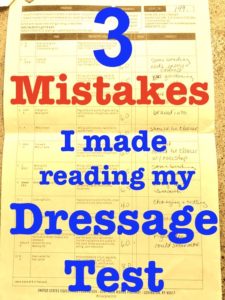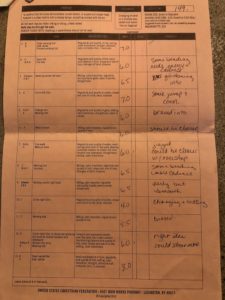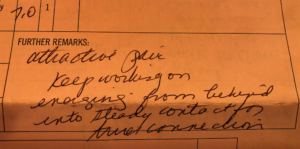 “I felt confused and slightly disappointed…”
“I felt confused and slightly disappointed…”
When I rode my first dressage test I thought I had done the hard part… until I tried to read the results. I had taken the time to memorize the movements but I had paid little attention to the rest of the test.
Although I was told I should be happy with my score, I found myself confused and slightly disappointed, until I learned how to understand what I was looking at.
Here are the three main mistakes when first looking at my first test.
- I didn’t understand what the numbers meant
- I didn’t understand why the judge sounded so harsh
- I didn’t know what coefficients were

Click to enlarge: 2015 USEF Training Level Test 3
Let’s take a look at one of my tests and I’ll explain.
Mistake #1- Not knowing the meaning of the numbers
Headed into the show I was thinking big picture. I asked what score I should hope for (they said 60%) but I never asked for more detail. If I had looked up the following number definitions I would have understood why 60% was even my goal.
10-Excellent
9-Very Good
8-Good
7-Fairly Good
6-Satisfactory
5-Marginal
4-Insufficient
3-Fairly Bad
2-Bad
1-Very Bad
0-Not Executed
Note: The judge can also use half marks which means you can receive a 5.5, 6.5, 7.5, etc.
Mistake #2- I thought the judge sounded harsh but…
As I scanned my test the comments jumped out at me.
“Tight in the back”
“Need more bend in loops”
“Needs more forward”
“Needs energy & cadence”
“Braced into”
“Should be clearer”
“Could show more”
“Short behind at times”
“Should stretch more”
The comments mostly seemed negative although on the back of the test the last remark was, “Attractive pair.” Talk about confused.

Most of the comments may at first glance seem harsh. They are intended to tell you how to improve.
The score was what I had hoped for (above 60%). The comments were mostly negative. But the judge thought we were an ‘attractive pair.’ I was clearly missing something.
What I’ve learned since that first test is that the comments are pointing out what I could improve on. It turns out that in order to improve, I needed to know where to focus.
I initially saw the comment as negativity instead of a way to improve. Now I realize that the number could be telling me I was on track but the comment was telling me how to improve. For example: I could score a 7 (Fairly Good) and still receive a comment like ‘gets quick’. While the number is telling me I am above satisfactory, the comment is telling me what I could improve to score even higher.
Mistake #3-Coefficients: Not all movements are equal
When I showed my test to a friend she remarked ‘too bad that happened on the coefficient’.
The what?
It turns out that some movements on the test count for twice as much. While the judge scores each movement individually against a standard, each test has movements that are emphasized. These specific movements are doubled. These movements are clearly marked on each test (see photo).

Had I known how to read the test before I rode, I would have realized that certain movements were more heavily weighted. At first, I wanted to kick myself for not knowing this but looking back at my first test I realized it would not have mattered. My mind was already on overload trying to remember everything else so I doubt knowing would have changed my first ride. Now, with a few more shows under my belt, I do put an emphasis on practicing the coefficient movements at home.
Which is exactly the point.
When I show, I still show all movements equally without considering the coefficients as I show but I can see that the added practice at home has improved these areas.
Conclusion
I hope this article helps you avoid the confusion I felt when reading my first test. The tests are more than a list of movements strung together. It is a progression of movements stacked inside a progression of tests with the goal of developing both horse and rider.
Give it a try! I’m glad I did.
10 Comments
Leave a Comment

FREE PDF DOWNLOAD
WHY IS MY HORSE...?
100% Private - 0% Spam
No one taught you the skills you need to work through these things.
Riders often encounter self-doubt, fear, anxiety, frustration, and other challenging emotions at the barn. The emotions coursing through your body can add clarity, or can make your cues indistinguishable for your horse.
Learning these skills and begin communicating clearly with your horse.
Click here to learn more.

Thank you for this post! I’ve got my first (virtual) show coming up in Western Dressage, and my mare is pretty green still. The video isn’t due until the end of the month, so I still have time to practice, however I am looking forward to seeing the comments from the judge! We can’t get better without those comments, even (especially?) if we don’t place!
So true! Entering online shows is so beneficial…especially with a green horse. That’s how I showed Presto for the first time!
Stacy – I rode my first dressage test two years ago and thought “why all the negativity?? I suck!!”. But then I scribed for the first time at the recent MODA show (and coincidentally your two tests) It was my first time scribing and I also thought “what? These horses look fantastic! More bend?? Where?” . Everything I wrote down looked like a list of grievances!! But the judge explained so much to me during each person’s ride and she was so positive and added really encouraging notes at the end. I think everyone should scribe at least once to understand what’s going on!!! It was so illuminating!! I couldn’t wait to go home and practice!
LOL! Thank you for confirming I’m not the only one who had that first thought:)
That is funny that you got to scribe for my tests. Was that the May show or August show?
I really do need to find a show I’m not showing in so I can scribe.
I second the advice to scribe if you can. However, remember that as a scribe, you are there to write down what the judge says so they can keep their eyes on the exhibitor, so that means YOU won’t be able to look up and see everything the judge sees. You have a job to do and can only glance up when not writing. That being said, the judge I scribed for was very kind and didn’t mind an occasional question in between tests.
I scribes for a dressage judge once— I was amazed at all the useful info they provided to help you improve. I wish they did something like that in reining.
I should find a show I’m not showing at and scribe. I’m not sure if I can write that fast! I’ve also had fun learning to read the shorthand. It is a bit like removing vowels and drawing boxes to represent ‘square’ lol!
scribing is incredibly helpful – I event – I scribed at a show before I ever evented and I realized that they aren’t always looking for what you think they are, and each movement is just that – one movement, if isn’t going well, school it, you’ve already lost some marks, so that the next movement will be better.
if you do decide to scribe, look up some of the dressage short hand so that your hand doesn’t break haha.
https://www.usdf.org/EduDocs/Competition/Scribing1011.pdf
Thank you for sharing, showing and learning with criticism like this is hard to understand when first learning, I was struggling with the judges comments when I first started Cowboy Obstacles, after 4 years, I have finally understand what they mean and know what they are looking for, sometimes it is off putting to certain people. You just can’t be thin skinned when learning is the bottom line.
I do love the comments now that I understand. In reining we see the numbers only. I’m glad more disciplines are using them!